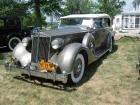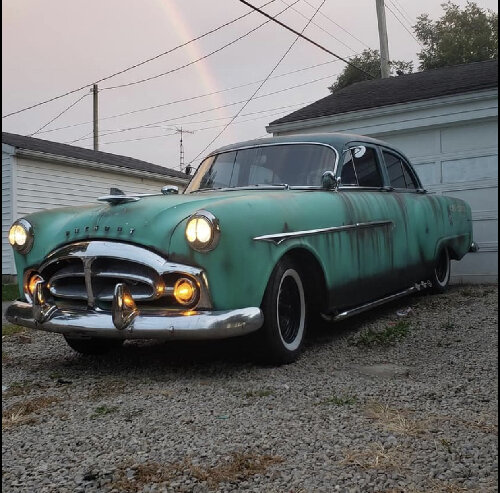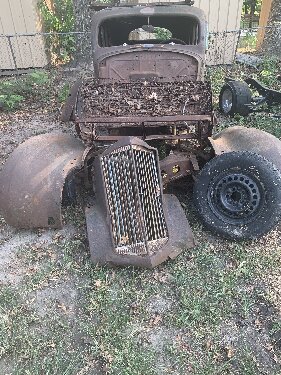|
Re: How clothes pins work to cure "vapor lock"
|
||||
|---|---|---|---|---|
|
Just can't stay away
|
Small current? How about 15-20 AMPS?
I'll disagree with Fred about cooling of the fuel pumps. May we may use my 1989 Mustang 5.0 H.O as an example? At 100% duty cycle this pump is designed to flow enough fuel to feed eight nineteen pound per hour injectors at 40 PSI (plus minus 4#). These pump motors generate enormous amounts of heat and that is the number one killer of in tank EFI fuel pumps. They are mounted inside the tank for pump cooling, priming and simplicity to manufacture. Three major causes of EFI in tank pump over heat is running our of fuel and the pump goes dry, a plugged suction screen, or a bad pressure regulator, all result in over heat situation.  Call me anal retentive but all my EFI vehicles are Fords (love them) and if they run out of fuel, I change the pump and filter as a matter of course. Been around too many that weren't and I don;t want my wife or kids (or myself) stranded in BFE at 2am. I have a feeling that what may be miss diagnosed as fuel vapor lock on our Packards isn't more attributed to primary ignition coils over heating. both will give the same symptoms. I live in in a place that sees well over 115F temps in the summer. I have yet to (now jinxed)have any issues driving the Packard. I also don;t have a stock coil in my 29 or an electric fuel pump. My coil is mounted under the dash on the upper right hand side of the fire wall and it has a massive heat sink. I would strongly suggest that if you are having running issues with your classic cars, then you should invest in an IR heat gunhttp://www.fluke.com/fluke/usen/electrical-test-tools/thermometers/fluke-62.htm?PID=56096 and measure your fuel tank, fuel lines, vacuum tank fuel pump (if equipped) and especially your ignition coil if you are having these issues. I have mine, do you have yours?
Posted on: 2011/5/30 11:29
|
|||
|
IF YOU DO NOT HAVE FLAMES COMING OUT OF THE STACK< YOU ARE NOT RUNNING TO YOUR FULL POTENTIAL.
|
||||
|
||||
|
Re: How clothes pins work to cure "vapor lock"
|
||||
|---|---|---|---|---|
|
Home away from home

|
Paul K,
Point well taken, it seems that not only others are speaking out of their area of experience/knowledge. While I am familiar with all types of pumps I've no experience with replacement and failure analysis on modern FI pumps. Having seen many in-tank pumps with their thin wires I assumed the current draw was low. I will find specs, but I speculate that it is not 15-20 amps. Perhaps that is the size of the fuse?? The issue of FI in-tank pumps in modern cars is a red herring anyway, it was brought into the discussion of old cars that exhibit symptoms of fuel starvation. There is good reason to keep on point. On the theory that an overheated coil is at fault, the 51-4 Packard Svc manual says it is possible but does not happen often. RESULTS OF CURRENT DRAW ISSUE FROM POPULAR MECHANICS Look this up in a service manual or via your PM CD-ROM. Ditto for the specs, but we will say that if you see anything over 5 amps with a low- to mid-pressure system (13 to 45 psi), or 7 amps with a high-pressure version (60 psi) you've got a problem. NOTE 15-20 AMP FUSE WOULD BE REASONABLE Avg 6 amps at 12 volts=72 watts, some mechanical, some heat From reasonable internet research ( and some of it is as poor as some of the comments here!) the leading cause of failure of these pumps is overheating. The leading cause of overheating is a clogged in tank filter or crud in the pump from guess what....rust in the gas tank
Posted on: 2011/5/30 20:24
|
|||
|
||||
|
Re: How clothes pins work to cure "vapor lock"
|
||||
|---|---|---|---|---|
|
Home away from home

|
Four + pages in this thread and thus far i have seen no statement for the REMEDY of vapor lock with respect to MODERN gasoline.
Posted on: 2011/5/30 22:07
|
|||
|
VAPOR LOCK demystified: See paragraph SEVEN of PMCC documentaion as listed in post #11 of the following thread:f
https://packardinfo.com/xoops/html/modules/newbb/viewtopic.php?topic_id=7245 |
||||
|
||||
|
Re: How clothes pins work to cure "vapor lock"
|
||||
|---|---|---|---|---|
|
Home away from home
|
I am currently experimenting with a 5% mixture of diesel fuel to a tank of gasoline in my '47 Clipper Custom. The car exhibited all the classic signs of vapor lock on a recent drive home from a car show. Since adding the diesel, the problem has not reappeared. Time will tell, but so far so good...
(o{I}o)
Posted on: 2011/5/30 22:12
|
|||
|
We move toward
And make happen What occupies our mind... (W. Scherer) |
||||
|
||||
|
Re: How clothes pins work to cure "vapor lock"
|
||||
|---|---|---|---|---|
|
Home away from home

|
Thanks JW. THe 5% diesel i have not tried yet. But my vapor lock SYMPTOMS are very short lived at maybe only 4 to 10 seconds at a time of engine stumble.
What has been the symptoms of your vapour lock???? Does the engine stop and refuse to start or run until it has cooled off for more than say 10 minutes or how does it act when the vapor lock sets in????
Posted on: 2011/5/30 22:24
|
|||
|
VAPOR LOCK demystified: See paragraph SEVEN of PMCC documentaion as listed in post #11 of the following thread:f
https://packardinfo.com/xoops/html/modules/newbb/viewtopic.php?topic_id=7245 |
||||
|
||||
|
Re: How clothes pins work to cure "vapor lock"
|
||||
|---|---|---|---|---|
|
Home away from home

|
PackardV8 Quote:
Four + pages in this thread and thus far i have seen no statement for the REMEDY of vapor lock with respect to MODERN gasoline. I don't know what thread you've been reading, but as stated previously, the "REMEDY" for vapor lock is MORE FUEL PRESSURE. Back to my anecdotal info on the drive up the long grade in 110F, which is about as severe conditions as one is likely to encounter. The carburated vehicle that made it up the grade was a 1989 Caprice converted from FI to Edelbrock carb/intake. I had fitted a big Holley bypass regulator (back through the stock tank return line) up front with a short line to the carb at 5psi (incoming line pressure was 45psi from the in tank electric fuel pump). The Caprice had NO mechanical fuel pump. The 1977 Firebird which did NOT make it up the hill had a stock fuel system with mechanical fuel pump & stock return to tank plus an electric pulse-type pusher fuel pump between the tank and mechanical fuel pump. The Firebird had never had any problems prior to that even in similar temperatures, but not a long pull up that (local 2800-5200ft) grade. For the record, the Firebird made it to within a few hundred yards of the summit before quitting although it was sputtering pretty good prior to that. We ended up leaving it in the shade under a tree near the summit for several hours until we came back on the return trip from Las Vegas. It started right up and drove home (downhill) no problem, with the temp still at 110F. BTW, the 3rd car in that caravan was a 1989 BMW L6 which is of course fuel injected. It even had the A/C on (the Caprice and Firebird did not) and it never sputtered once. I believe that if the Firebird had been equipped with a higher pressure electric fuel pump (Carter 6psi rotary vane, for example, rather than the 4psi of the generic NAPA pulse type), it would have made it up the grade too. Despite the ages of the 3 cars (one 1977, two 1989), this incident occurred only a couple of years ago, so we are dealing with "modern gasoline" (actually 10% ethanol mix from Pahrump, NV, so it's a worst case). Craig
Posted on: 2011/5/31 0:32
|
|||
|
Nuke them from orbit, it's the only way to be sure! Ellen Ripley "Aliens"
Time flies like an arrow. Frui |
||||
|
||||
|
Re: How clothes pins work to cure "vapor lock"
|
||||
|---|---|---|---|---|
|
Webmaster
|
Perhaps an example of Human Vapor lock is needed. At 62,000 feet, human blood boils. The cure for this? Pressurized suits/cabins.
As said over and over Fluids boil at lower temps when the pressure is reduced. As Craig as others have said, the cure for vapor lock is either high fuel pressure, or reduced temperature on the vacuum side of the pump. No fantasy physics here, or magical clothes pin technology needed. While I don't really like to reply on wikipedia for information, I think their explanation is as good as any: http://en.wikipedia.org/wiki/Vapor_lock
Posted on: 2011/5/31 0:50
|
|||
|
-BigKev
1954 Packard Clipper Deluxe Touring Sedan -> Registry | Project Blog 1937 Packard 115-C Convertible Coupe -> Registry | Project Blog |
||||
|
||||
|
Re: How clothes pins work to cure "vapor lock"
|
||||
|---|---|---|---|---|
|
Home away from home

|
BigKev
Thanks for researching on Wikipedia, everyone on this topic should read both subjects, "vapor lock" and "flooding". On the subject of flooding, Packard indicated in the 51-4 Manual that it was th most likely cause of a no start condition when the motor is hot. Most members posting here have ignored my post to that effect and are chasing the hot coil/vapor lock demons. I have a 78 Buick Electra 350/4bbl that had a hot start problem one day, suspected a fuel system problem. Removed air cleaner, poured in 1 oz gas, REPLACED AIR CLEANER and it would not fire. Smelled the tail pipe,it was flooded. Had a liesurely Corona, then it sarted fine. There are reasoned, logical causes and solutions which can be found through sifting the baloney out of the stew. Lets all try to keep it that way.
Posted on: 2011/5/31 5:28
|
|||
|
||||
|
Re: How clothes pins work to cure "vapor lock"
|
||||
|---|---|---|---|---|
|
Home away from home

|
Carigs test:
"The carburated vehicle that made it up the grade was a 1989 Caprice converted from FI to Edelbrock carb/intake." Does the Edelbrock intake MANIFOLD have any exhaust heat passages or any other deliberate/design of the intake MANIFOLD to provide any heat to the carburestor????
Posted on: 2011/5/31 7:02
|
|||
|
VAPOR LOCK demystified: See paragraph SEVEN of PMCC documentaion as listed in post #11 of the following thread:f
https://packardinfo.com/xoops/html/modules/newbb/viewtopic.php?topic_id=7245 |
||||
|
||||
Register To PostTopic is Locked










